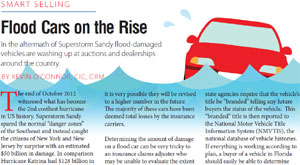 As New Jersey and other areas of the Atlantic coast continue to rebuild in the wake of Superstorm Sandy, another threat from the storm and all of its flooding has begun to surface. According to insurance experts, consumers should be on the lookout for flood-damages cars and vehicles which are beginning to show up at auto auctions and car dealerships around the country.
As New Jersey and other areas of the Atlantic coast continue to rebuild in the wake of Superstorm Sandy, another threat from the storm and all of its flooding has begun to surface. According to insurance experts, consumers should be on the lookout for flood-damages cars and vehicles which are beginning to show up at auto auctions and car dealerships around the country.
According to Kevin O’Connor, with Dealers Insurance Services, more than 500,000 vehicles are estimated to have suffered from flood damage. In an article posted on the company’s web site (www.dealersinsurance.com), O’Connor explains that, even at minimal amounts, the vehicle damage from storm surge salt water almost always causes vehicle damage beyond reasonable repairs. “While the vehicle may be able to be cleaned up and even run well for a period of time, its rapid deterioration is inevitable. Electrical issues, frame and engine corrosion, failing brakes and even mold will start to surface. The car eventually becomes unsafe to drive, if it even continues to run at all.”
Last February, the National Insurance Crime Bureau (NICB), a not for-profit organization that receives data from nearly 1,100 property and casualty insurance companies, released estimates of approximately 250,000 insurance claims on vehicles as a result of Sandy. Because thorough inspections of these damaged vehicles, especially troubleshooting the electrical components and systems, is well beyond the scope, expertise and tools of an independent, insurance company approved body shop, it almost impossible for an insurance company to estimate the cost of repair. As a result, most treat the vehicle as a total loss.
These totaled vehicles are supposed to then have their title “branded” which tells future buyers the status of the vehicle. The National Motor Vehicle Title Information System (NMVTIS) maintains the national database of vehicle histories, and if the system works as designed for example, a buyer of a vehicle in Florida should easily be able to determine if that vehicle had been totaled by an insurance company.
However, as O’Connor points out, the NMVTIS isn’t perfect and current reports indicate that some insurance carriers not “branding” the title as required or reporting it prior to its sale at salvage auctions. What’s more, even in instances where the title is branded properly, the vehicle are often moved to another state and retitled under that state’s laws as a clean title through a process called title “washing.”
“In addition to the issues the NMVTIS project has, it doesn’t address any of the estimated 250,000 uninsured vehicles. The sad truth is that many of these vehicles are making their way back into the marketplace and being sold to unsuspecting buyers as well,” says OÇonnor.
In his complete article, O’Connor, who has been helping dealers with insurance needs for 27 years, suggests several ways in which consumers and dealers can try to protect themselves against buying a flood-damaged vehicle. Included among the suggestions is getting a Post-Sale inspection (PSI) when offered at the auction. The PSI includes a rigorous check of the vehicle for numerous items including flood damage. At a price typically ranging between $75 and $100, it could save a lot of money in the long run.
For more tips and to read the complete article, go online to: www.dealersinsurance.com.
![Herbal Reference Substances are Key to Everyday Products <!-- AddThis Sharing Buttons above -->
<div class="addthis_toolbox addthis_default_style " addthis:url='http://newstaar.com/herbal-reference-substances-are-key-to-everyday-products/3512112/' >
<a class="addthis_button_facebook_like" fb:like:layout="button_count"></a>
<a class="addthis_button_tweet"></a>
<a class="addthis_button_pinterest_pinit"></a>
<a class="addthis_counter addthis_pill_style"></a>
</div>When it comes to quality control testing and the development of new products, Botanical Reference Materials (BRMs), also known as Herbal References are critically important. To help companies ultimately obtain all-important FDA approval, the Food and Drug Administration provides in its guidance a recommendation that […]<!-- AddThis Sharing Buttons below -->
<div class="addthis_toolbox addthis_default_style addthis_32x32_style" addthis:url='http://newstaar.com/herbal-reference-substances-are-key-to-everyday-products/3512112/' >
<a class="addthis_button_preferred_1"></a>
<a class="addthis_button_preferred_2"></a>
<a class="addthis_button_preferred_3"></a>
<a class="addthis_button_preferred_4"></a>
<a class="addthis_button_compact"></a>
<a class="addthis_counter addthis_bubble_style"></a>
</div>](http://newstaar.com/wp-content/uploads/2021/02/Achillea_millefolium_flowers-100x100.jpg)
![Quality Electrochemical Biosensors are Critical for Medical, Food and Chemical Industry <!-- AddThis Sharing Buttons above -->
<div class="addthis_toolbox addthis_default_style " addthis:url='http://newstaar.com/quality-electrochemical-biosensors-are-critical-for-medical-food-and-chemical-industry/3512086/' >
<a class="addthis_button_facebook_like" fb:like:layout="button_count"></a>
<a class="addthis_button_tweet"></a>
<a class="addthis_button_pinterest_pinit"></a>
<a class="addthis_counter addthis_pill_style"></a>
</div>A number of industries have, at their core, a need to frequent or even continuous analysis of biological media. These include the medical and pharmaceutical fields, biotech firms, and food and chemical companies. To maintain quality standards and develop new products, these industries rely heavily […]<!-- AddThis Sharing Buttons below -->
<div class="addthis_toolbox addthis_default_style addthis_32x32_style" addthis:url='http://newstaar.com/quality-electrochemical-biosensors-are-critical-for-medical-food-and-chemical-industry/3512086/' >
<a class="addthis_button_preferred_1"></a>
<a class="addthis_button_preferred_2"></a>
<a class="addthis_button_preferred_3"></a>
<a class="addthis_button_preferred_4"></a>
<a class="addthis_button_compact"></a>
<a class="addthis_counter addthis_bubble_style"></a>
</div>](http://newstaar.com/wp-content/uploads/2020/10/Electrochemical-Biosensor-100x100.jpg)
![Company Develops Industrial Mixers Well-Suited for both Fragile and Explosive Products <!-- AddThis Sharing Buttons above -->
<div class="addthis_toolbox addthis_default_style " addthis:url='http://newstaar.com/company-develops-industrial-mixers-well-suited-for-both-fragile-and-explosive-products/3512071/' >
<a class="addthis_button_facebook_like" fb:like:layout="button_count"></a>
<a class="addthis_button_tweet"></a>
<a class="addthis_button_pinterest_pinit"></a>
<a class="addthis_counter addthis_pill_style"></a>
</div>Industrial drum mixers are normally applied to blend mixes of varying viscosities such as adhesive slurries or cement. Some of these mixers have the capability of blending mixes of very different particle sizes such as fruit and ice cream, and gravel and cement slurry. The […]<!-- AddThis Sharing Buttons below -->
<div class="addthis_toolbox addthis_default_style addthis_32x32_style" addthis:url='http://newstaar.com/company-develops-industrial-mixers-well-suited-for-both-fragile-and-explosive-products/3512071/' >
<a class="addthis_button_preferred_1"></a>
<a class="addthis_button_preferred_2"></a>
<a class="addthis_button_preferred_3"></a>
<a class="addthis_button_preferred_4"></a>
<a class="addthis_button_compact"></a>
<a class="addthis_counter addthis_bubble_style"></a>
</div>](http://newstaar.com/wp-content/uploads/2020/06/bandeau-sofragir2-100x100.jpg)